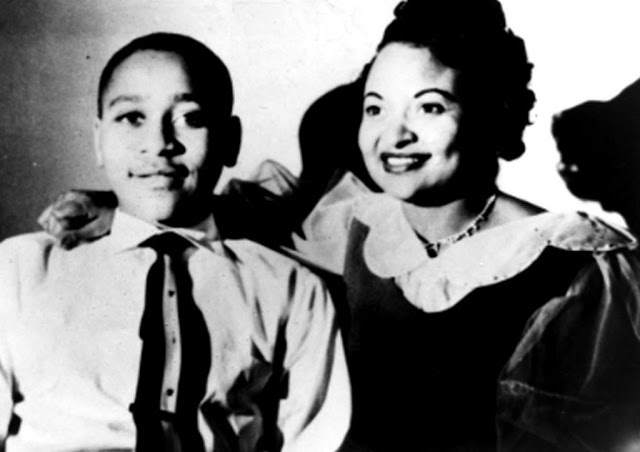
For someone who was murdered 62 years ago, Emmett Till has never seemed more alive.
Whoopi Goldberg is said to have been signed to direct a feature film, with another in the offing produced by Chaz Ebert, the widow of the critic Roger Ebert. A six-part HBO series, with Jay Z and Will Smith among the producers, is in production. The National Museum of African American History and Culture opened an exhibition late last year, while there have been a flurry of books, an Off-Off-Broadway play and earlier this month a New York Times editorial.
Till is the 14-year-old black kid with the incredibly sweet face from suburban Chicago who, while visiting relatives in backwater Mississippi in August 1955, allegedly flirted with Carolyn Bryant, a  21-year-old white woman with movie star good looks who worked the cash register at a rural grocery and meat market.
21-year-old white woman with movie star good looks who worked the cash register at a rural grocery and meat market.
Bryant later told her husband and his half brother of her encounter. They drove to the house of Till’s preacher uncle, forced their way inside, dragged Emmett from his bed, and then had Bryant, who was waiting in their vehicle outside, identify him. The youngster was later beaten until his skull collapsed, and shot in the right ear. A 74-pound iron cotton gin ventilating fan was tied to his neck with several feet of barbed wire and his body thrown into the muddy waters of the Tallahatchie River. His tongue was swollen beyond recognition when his body was found three days later. His right eyeball was hanging from the optic nerve and his left eyeball was gone altogether, and he was identified only because of a silver ring he was wearing engraved with the initials of his father, who was killed defending American values in World War II.
The murder would never have caused a ripple beyond the deeply segregated Delta community — after all, hundreds of lynchings across the South during the Jim Crow era never did — had it not been for Emmett’s mother, Mamie Till Mobley.
Mississippi authorities wanted to bury Till as soon as possible, but Mobley interested journalists in the story, which became a sensation after she insisted on a public funeral in Chicago with an open coffin that revealed to the world Emmett’s mutilated face and bloated body. Although an undertaker made cosmetic repairs, a widely published photograph revealed a body lying in state with a head that did not even appear to be human.
The murder and subsequent viewing and funeral, one of the first major television events and attended by 100,000 people by conservative estimates, was to jump start the civil rights movement four months before Rosa Parks triggered the Montgomery, Alabama, bus boycott by refusing to yield her bus seat to a white man.
Now comes a just-published book that fills in a gaping hole in the Till story.
Outside of private correspondence, trial testimony long believed to be perjurious and an unpublished memoir, Carolyn Bryant had refused to speak about what happened that sultry afternoon until she reached out to Duke University research scholar Timothy B. Tyson. The account related to Tyson by the now 83-year-old Bryant is the sensational centerpiece of The Blood of Emmett Till, an exhaustive and extensively documented account of this horrifyingly tragic chapter of Americans not getting along, and where it fits in the historic mosaic of the travails of black Americans from slavery to the relative successes of the civil rights crusades and most recently the Black Lives Matter movement.
Till’s lynching was triggered not by an insult or a wolf whistle, as Bryant had told husband Roy and his half brother J.W. “Big” Milam in various accounts, nor by Emmett grabbing her around the waist and uttering obscenities, an implication that he had stopped just short of attempted rape, as she falsely testified in court, but merely by violating a race taboo unknown to a teenager from up North: Failing to put on the counter the coin he pulled from a pants pocket for a piece of bubble gum. He instead had dropped it into Bryant’s hand.
Roy Bryant and Milam were arrested for the murder after intense national media scrutiny on the plight of blacks in Mississippi rallied black support and, in the North, white sympathy. This soon translated into local support for the killers and even accusations in the white press that the NAACP had murdered Till to garner sympathy for the cause of desegregation. Bryant and Milam were brought to trial a mere three weeks after Till’s body was pulled from the Tallahatchie to assure there would not be a thorough investigation. Witness and jury tampering and other efforts to undermine the prosecution’s case were superfluous as the men were quickly found not guilty by an all-white, all-male jury after an hour — and only that long because, as one juror later acknowledged, “to make it look good.”
The Blood of Emmett Till recalls to mind the 2015 massacre of nine black parishioners in a Charleston church and the 1998 murder of James Byrd Jr., a black man who was abducted by three white men and dragged to his death from the back of a pickup truck in Texas, among other contemporary hate crimes, a form of terrorism that somehow doesn’t get the attention that those jihadist crazies reliably do. In other words, while Till has been dead for more than half a century, racism of the most violent and unspeakable kind continues to flourish in America.
Then and now, that racism has been every bit as present in Mamie Till Mobley’s Chicago and elsewhere in the North. It just lurks a little deeper below the surface as shown by the animus against Barack Obama and embrace of Donald Trump.
By the numbers, as many blacks have perished at the hands of whites above the Mason-Dixon Line as below it, but the Deep South that has worn the racial taboos that killed Emmett as proudly as it has flown the Confederate battle flag still deserves special scorn. Till’s lynching was blamed on Yankees and that ever present international communist conspiracy in general and specifically the landmark Brown v. Board of Education ruling of the year before that ordered the desegregation of public schools. Underlying all of this was the terror of miscegenation.
And try as he might, Trump Attorney General Jeff Sessions cannot whitewash his own racist past, let alone those of his forebears, in solemnly declaring that he will uphold the nation’s laws for blacks and whites and Christians and Muslims alike.
“You tell these stories for so long that they seem true, Carolyn Bryant told Tyson. “Nothing that boy did could ever justify what happened to him.”
So then how should we feel about Bryant after her long belated admission that she repeatedly exaggerated and lied, as well as her expressions of remorse? Hatred? Forgiveness? Or perhaps something in between? I don’t know because all I can think of is what must have been going through Emmett Till’s mind as he was being butchered.
“From this tragedy large,” wrote Tyson, “Diverse numbers of people organized a movement that grew to transform a nation, not sufficiently but certainly meaningfully. What matters most if what we have done and will do with what we know.”
















